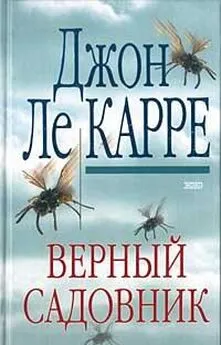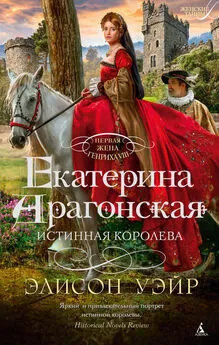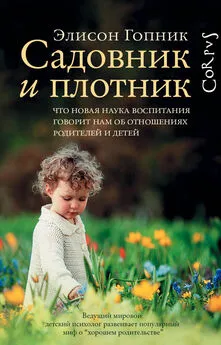Элисон Гопник - Садовник и плотник [litres]
- Название:Садовник и плотник [litres]
- Автор:
- Жанр:
- Издательство:Литагент Corpus
- Год:2019
- Город:Москва
- ISBN:978-5-17-101296-0
- Рейтинг:
- Избранное:Добавить в избранное
-
Отзывы:
-
Ваша оценка:
Элисон Гопник - Садовник и плотник [litres] краткое содержание
Садовник и плотник [litres] - читать онлайн бесплатно ознакомительный отрывок
Интервал:
Закладка:
Pigliucci, Massimo. “Is Evolvability Evolvable?” Nature Reviews Genetics 9, no. 1 (2008): 75–82. doi: 10.1038/nrg2278.
Pollan, Michael. The Omnivore’s Dilemma: A Natural History of Four Meals . New York: Penguin, 2006. [Рус. изд.: Майкл Поллан. Дилемма всеядного. Шокирующее исследование рациона современного человека. М.: Эксмо, 2017.]
Polley, Daniel B., Elizabeth Steinberg, and Michael M. Merzenich. “Perceptual Learning Directs Auditory Cortical Map Reorganization Through Topdown Influences.” The Journal of Neuroscience 26, no. 18 (2006): 4970–4982. doi: 10.1523/JNEUROSCI.3771–05.2006.
Popper, Karl R. The Logic of Scientific Discovery . London: Hutchinson and Co., 1959. [Рус. изд.: Карл Поппер. Логика научного исследования. М.: Республика, 2004.]
Posner, Michael I., and Mary K. Rothbart. Educating the Human Brain . Washington, D. C.: American Psychological Association, 2007.
Potts, Richard. “Evolution and Climate Variability.” Science 273, no. 5277 (1996): 922s.
Pritchard, Colin, and Richard Williams. “Poverty and Child (0–14 Years) Mortality in the USA and Other Western Countries as an Indicator of ‘How Well a Country Meets the Needs of Its Children’ (UNICEF).” International Journal of Adolescent Medicine and Health 23, no. 3 (2011): 251–255. doi: 10.1515/ijamh.2011.052.
Ramachandran, Vilayanur S. The Tell-Tale Brain: A Neuroscientist’s Quest for What Makes Us Human . New York: W. W. Norton and Co., 2012.
Rapp, Emily. “Notes from a Dragon Mom.” New York Times , October 15, 2011. Accessed October 28, 2015. http://www.nytimes.com/2011/10/16/opinion/sunday/notes-from-a-dragon-mom.html?r=0.
Rapp, Emily. The Still Point of the Turning World. New York: Penguin, 2014.
Reichard, Ulrich H., and Christophe Boesch, eds. Monogamy: Mating Strategies and Partnerships in Birds, Humans and Other Mammals . Cambridge: Cambridge University Press, 2003.
Reps, Paul, and Nyogen Senzaki, compilers. Zen Flesh, Zen Bones: A Collection of Zen and Pre-Zen Writings . Boston: Tuttle Publishing, 1998. [Рус. изд.: Плоть и кость дзен. Пер. В. Нелина. М.: АСТ, 2016.]
Revedin, Anna, Biancamaria Aranguren, Roberto Becattini, Laura Longo, Emanuele Marconi, Marta Mariotti Lippi, Natalia Skakun, Andrey Sinitsyn, Elena Spiridonova, and Jiří Svoboda. “Thirty-Thousand-Year-Old Evidence of Plant Food Processing.” Proceedings of the National Academy of Sciences 107, no. 44 (2010): 18815–18819. doi: 10.1073/pnas.1006993107.
Rhodes, Marjorie. “Naive Theories of Social Groups.” Child Development 83, no. 6 (2012): 1900–1916. doi: 10.1111/j.1467–8624.2012.01835.x.
Rhodes, Marjorie, Sarah-Jane Leslie, and Christina M. Tworek. “Cultural Transmission of Social Essentialism.” Proceedings of the National Academy of Sciences 109, no. 34 (2012): 13526–13531. doi: 10.1111/1467–9280.00194.
Ritchart, Amanda, and Amalia Arvaniti. “The Use of High Rise Terminals in Southern Californian English.” The Journal of the Acoustical Society of America 134, no. 5 (2013): 4197–4198. doi: 10.1121/1.4831401.
Rizzolatti, Giacomo, Leonardo Fogassi, and Vittorio Gallese. “Neurophysiological Mechanisms Underlying the Understanding and Imitation of Action.” Nature Reviews Neuroscience 2, no. 9 (2001): 661–670. doi: 10.1038/35090060.
Rogoff, Barbara. Apprenticeship in Thinking: Cognitive Development in Social Context . New York: Oxford University Press, 1990.
Rogoff, Barbara. The Cultural Nature of Human Development . Oxford and New York: Oxford University Press, 2003.
Ross, Norbert, Douglas Medin, John D. Coley, and Scott Atran. “Cultural and Experiential Differences in the Development of Folkbiological Induction.” Cognitive Development 18, no. 1 (2003): 25–47. doi: 10.1016/S0885–2014 (02) 00142–9.
Sankoff, Gillian, and Suzanne Laberge. “On the Acquisition of Native Speakers by a Language.” In Pidgins and Creoles: Current Trends and Prospects , edited by David DeCamp and Ian F. Hancock, 73–84. Washington, D. C.: Georgetown University Press, 1974.
Sénéchal, Monique, and Jo-Anne LeFevre. “Parental Involvement in the Development of Children’s Reading Skill: A Five-Year Longitudinal Study.” Child Development 73, no. 2 (2002): 445–460. doi: 10.1111/1467–8624.00417.
Senior, Jennifer. All Joy and No Fun: The Paradox of Modern Parenthood . New York: HarperCollins Publishers, 2014. [Рус. изд.: Дженнифер Сениор. Родительский парадокс. Море радости в океане проблем. Как быть счастливым на все 100 %. Пер. К. Пискаревой. М.: Эксмо, 2015.]
Shaw, Philip, Deanna Greenstein, Jason Lerch, Liv Clasen, Rhoshel Lenroot, N. Gogtay, Alan Evans, J. Rapoport, and J. Giedd. “Intellectual Ability and Cortical Development in Children and Adolescents.” Nature 440, no. 7084 (2006): 676–679. doi: 10.1038/nature04513.
Singer, Peter. Practical Ethics . New York: Cambridge University Press, 2011. Skolnick, Deena, and Paul Bloom. “What Does Batman Think About Sponge-Bob? Children’s Understanding of the Fantasy/Fantasy Distinction.” Cognition 101, no. 1 (2006): B9 – B18. doi: 10.1016/j.cognition.2005.10.001.
Slaby, Ronald G., and Karin S. Frey. “Development of Gender Constancy and Selective Attention to Same-Sex Models.” Child Development (1975): 849–856. doi: 10.2307/1128389.
Smith, Carol, Susan Carey, and Marianne Wiser. “On Differentiation: A Case Study of the Development of the Concepts of Size, Weight, and Density.” Cognition 21, no. 3 (1985): 177–237. doi: 10.1016/0010–0277 (85) 90025–3.
Smith, Kenny, Michael L. Kalish, Thomas L. Griffiths, and Stephan Lewandowsky. “Theme Issue: Cultural Transmission and the Evolution of Human Behaviour.” Philosophical Transactions of the Royal Society B: Biological Sciences 363, no. 1509 (2008).
Smith, Peter K., and Teresa Hagan. “Effects of Deprivation on Exercise Play in Nursery School Children.” Animal Behaviour 28, no. 3 (1980): 922–928. doi: 10.1016/S0003–3472 (80) 80154–0.
Smith, Tanya M., Paul Tafforeau, Donald J. Reid, Joane Pouech, Vincent Lazzari, John P. Zermeno, Debbie Guatelli-Steinberg, et al. “Dental Evidence for Ontogenetic Differences Between Modern Humans and Neanderthals.” Proceedings of the National Academy of Sciences 107, no. 49 (2010): 20923–20928. doi: 10.1073/pnas.1010906107.
Snowling, Margaret J. Dyslexia . Malden, Mass.: Blackwell Publishing, 2000.
Stahl, Aimee E., and Lisa Feigenson. “Observing the Unexpected Enhances Infants’ Learning and Exploration.” Science 348, no. 6230 (2015): 91–94. doi: 10.1126/science.aaa3799.
Standage, Tom. The Victorian Internet: The Remarkable Story of the Telegraph and the Nineteenth Century’s Online Pioneers . London: Weidenfeld and Nicolson, 1998.
Starck, J. Matthias, and Robert E. Ricklefs, eds. Avian Growth and Development: Evolution Within the Altricial-Precocial Spectrum . New York and Oxford: Oxford University Press, 1998.
Steinberg, Laurence. Age of Opportunity: Lessons from the New Science of Adolescence . Boston: Houghton Miffl in Harcourt, 2014.
Steinberg, Laurence. “Risk Taking in Adolescence: What Changes, and Why?” Annals of the New York Academy of Sciences 1021, no. 1 (2004): 51–58. doi: 10.1196/an nals.1308.005.
Sterelny, Kim. The Evolved Apprentice: How Evolution Made Humans Unique . Cambridge, Mass.: MIT Press, 2012.
Stevens, Gillian. “Age at Immigration and Second Language Profi ciency Among Foreign-Born Adults.” Language in Society 28, no. 4 (1999): 555–578.
Taylor, Marianne G., Marjorie Rhodes, and Susan A. Gelman. “Boys Will Be Boys; Cows Will Be Cows: Children’s Essentialist Reasoning About Gender Categories and Animal Species.” Child Development 80, no. 2 (2009): 461–481. doi: 10.1111/j.1467–8624.2009.01272.x.
Taylor, Marjorie. Imaginary Companions and the Children Who Create Them . Oxford and New York: Oxford University Press, 1999.
Taylor, Marjorie, and Stephanie M. Carlson. “The Relation Between Individual Differences in Fantasy and Theory of Mind.” Child Development 68, no. 3 (1997): 436–455. doi: 10.1111/j.1467–8624.1997.tb01950.x.
Taylor, Marjorie, Sara D. Hodges, and Adele Kohányi. “The Illusion of Independent Agency: Do Adult Fiction Writers Experience Their Characters as Having Minds of Their Own?” Imagination, Cognition and Personality 22, no. 4 (2003): 361–380. doi: 10.2190/FTG3-Q9T0-7U26-5Q5X.
Taylor, Marjorie, Candice M. Mottweiler, Emilee R. Naylor, and Jacob G. Levernier. “Imaginary Worlds in Middle Childhood: A Qualitative Study of Two Pairs of Coordinated Paracosms.” Creativity Research Journal 27, no. 2 (2015): 167–174. doi: 10.1080/10400419.2015.1030318.
Tenenbaum, Harriet R., and Maureen A. Callanan. “Parents’ Science Talk to Their Children in Mexican-Descent Families Residing in the USA.” International Journal of Behavioral Development 32, no. 1 (2008): 1–12. doi:10.1177/0165025407084046.
Tenney, Elizabeth R., Jenna E. Small, Robyn L. Kondrad, Vikram K. Jaswal, and Barbara A. Spellman. “Accuracy, Confidence, and Calibration: How Young Children and Adults Assess Credibility.” Developmental Psychology 47, no. 4 (2011): 1065–1077. doi: 10.1037/a0023273.
Tennie, Claudio, Josep Call, and Michael Tomasello. “Ratcheting Up the Ratchet: On the Evolution of Cumulative Culture.” Philosophical Transactions of the Royal Society B: Biological Sciences 364, no. 1528 (2009): 2405–2415. doi: 10.1098/rstb.2009.0052.
Tomasello, Michael. The Cultural Origins of Human Cognition . Cambridge, Mass.: Harvard University Press, 1999. [Рус. изд.: Майкл Томаселло. Истоки человеческого общения. Пер. М. В. Фаликман, Е. Печенковой, М. Синицыной. М.: Языки славянских культур, 2011.]
Tomasello, Michael. Why We Cooperate . Cambridge, Mass.: MIT Press, 2009. Tomasello, Michael, and Josep Call. Primate Cognition . New York and Oxford: Oxford University Press, 1997.
Turkheimer, Eric. “Three Laws of Behavior Genetics and What They Mean.” Current Directions in Psychological Science 9, no. 5 (2000): 160–164.
Turkheimer, Eric, and Mary Waldron. “Nonshared Environment: A Theoretical, Methodological, and Quantitative Review.” Psychological Bulletin 126, no. 1 (2000): 78.
Ungerleider, Leslie G., Julien Doyon, and Avi Karni. “Imaging Brain Plasticity During Motor Skill Learning.” Neurobiology of Learning and Memory 78, no. 3 (2002): 553–564. doi: 10.1006/nlme.2002.4091.
Van den Boom, Dymphna C. “The Influence of Temperament and Mothering on Attachment and Exploration: An Experimental Manipulation of Sensitive Responsiveness Among Lower-Class Mothers with Irritable Infants.” Child Development 65, no. 5 (1994): 1457–1477. doi: 10.1111/j.1467–8624.1994.tb00829.x.
Waismeyer, Anna, Andrew N. Meltzoff, and Alison Gopnik. “Causal Learning from Probabilistic Events in 24-Month-Olds: An Action Measure.” Developmental Science 18, no. 1 (2015): 175–182. doi: 10.1111/desc.12208.
Читать дальшеИнтервал:
Закладка:
![Обложка книги Элисон Гопник - Садовник и плотник [litres]](/books/1082744/elison-gopnik-sadovnik-i-plotnik-litres.webp)



![Элисон Диксон - Другая миссис Миллер [litres]](/books/1058289/elison-dikson-drugaya-missis-miller-litres.webp)


![Элисон Уэйр - Джейн Сеймур. Королева во власти призраков [litres]](/books/1074967/elison-uejr-dzhejn-sejmur-koroleva-vo-vlasti-prizr.webp)
![Элисон Робертс - Невероятная случайность бытия [Эволюция и рождение человека] [litres]](/books/1080754/elison-roberts-neveroyatnaya-sluchajnost-bytiya-evol.webp)
![Элисон Блэк - Особенные. Путь к совершенству [СИ]](/books/1092172/elison-blek-osobennye-put-k-sovershenstvu-si.webp)
